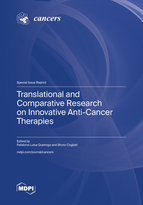Translational and Comparative Research on Innovative Anti-Cancer Therapies
A special issue of Cancers (ISSN 2072-6694). This special issue belongs to the section "Cancer Therapy".
Deadline for manuscript submissions: closed (15 March 2022) | Viewed by 42639
Special Issue Editors
Interests: small animals internal medicine; small animals oncology; small animals clinical pathology; small animals immunohistochemistry; small animals nefro-urology; small animals endocrinology
Special Issues, Collections and Topics in MDPI journals
Interests: experimental pathology; animal models; liver disease; veterinary oncology; hepatocellular carcinoma; anti-cancer therapies; biomarkers; comparative hepatology
Special Issue Information
Dear Colleagues,
Cancer represents a major global challenge for medical practice in humans and companion animals. A plethora of basic and pre-clinical studies, involving cell cultures and animal models, have been screening novel anti-cancer drugs and innovative treatments such as immunotherapy and gene-based therapy. In addition, emerging alternative translational models based on comparative oncology have been showing promising results in anti-cancer drug discovery since companion animals develop spontaneous tumors and share the same environment as humans. Nonetheless, some gaps still exist in pre-clinical and clinical comparative animal models, in terms of biological behavior, genetics, molecular pathways, as well as the immunological features of cancer that should be fulfilled to enhance their translational value.
This Special Issue welcomes both original papers, review articles and systematic reviews addressing in vitro and in vivo models on basic cancer research as well as pre-clinical and clinical studies focusing on the development of innovative anti-cancer therapies, including those in the scope of comparative oncology.
Dr. Felisbina Queiroga
Dr. Bruno Cogliati
Guest Editors
Manuscript Submission Information
Manuscripts should be submitted online at www.mdpi.com by registering and logging in to this website. Once you are registered, click here to go to the submission form. Manuscripts can be submitted until the deadline. All submissions that pass pre-check are peer-reviewed. Accepted papers will be published continuously in the journal (as soon as accepted) and will be listed together on the special issue website. Research articles, review articles as well as short communications are invited. For planned papers, a title and short abstract (about 100 words) can be sent to the Editorial Office for announcement on this website.
Submitted manuscripts should not have been published previously, nor be under consideration for publication elsewhere (except conference proceedings papers). All manuscripts are thoroughly refereed through a single-blind peer-review process. A guide for authors and other relevant information for submission of manuscripts is available on the Instructions for Authors page. Cancers is an international peer-reviewed open access semimonthly journal published by MDPI.
Please visit the Instructions for Authors page before submitting a manuscript. The Article Processing Charge (APC) for publication in this open access journal is 2900 CHF (Swiss Francs). Submitted papers should be well formatted and use good English. Authors may use MDPI's English editing service prior to publication or during author revisions.
Keywords
- anti-cancer therapies
- animal models
- in vitro assays
- clinical trials
- clinical oncology
- comparative oncology
- translational medicine







